
Official Edgar Rice Burroughs Tribute and Weekly Webzine Site First and Only Weekly Online Fanzine Devoted to the Life and Works of ERB Since 1996 ~ Over 15,000 Webpages in Archive |

Official Edgar Rice Burroughs Tribute and Weekly Webzine Site First and Only Weekly Online Fanzine Devoted to the Life and Works of ERB Since 1996 ~ Over 15,000 Webpages in Archive |
In darkest Tulse Hill you can, if you are observant, catch sight of a shadowy form who swings through the acacias as dusk starts to fall. He has the agility of an ape and the strength of Samson, but there is in his eyes a fire that hints at a certain aristocracy. For all his anthropoid antics, he exudes a confidence and serenity that put him on another plane, both physically and spiritually, from the crowds who trudge home below his branches every evening their brief cases and Evening Standards in their hands -- though he swings in the same direction as they do and, yes, he carries too a brief case and Standard of his own. For if you look very closely, and if I am brutally honest, it must be apparent that this mysterious suburban Tarzan is none other than myself.
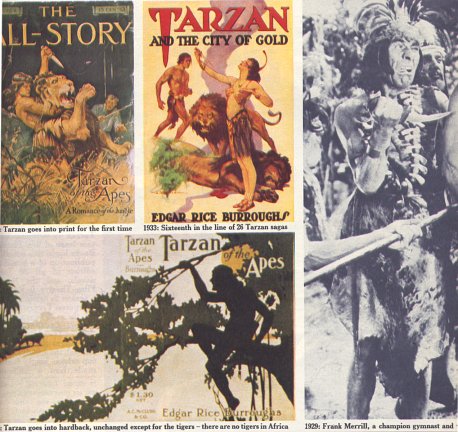 |
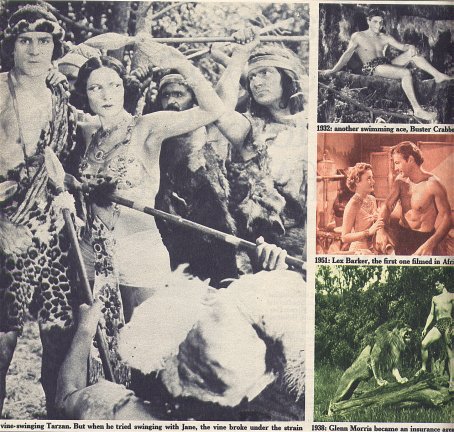 |
But I am not alone, am I, in my leafy hallucinations? For Tarzan swings every night through a thousand concrete jungles from Penge to Neasden and north of Potters Bar, throughout the suburbs of our nation and, as the evidence clearly shows, throughout the literate and illiterate world as well. There have been yellow Tarzans and black Tarzans; he has been translated into 30 languages -- plus Esperanto and Braille; hospital casualty wards have had to minister to up to 15 sub-teenage ape-men fallen out of trees in a single afternoon; and crowds have queued for the special promise that Tarzan bread, Tarzan ice-cream and Tarzan petrol can offer them.But that is hardly surprising, for this muscular archangel, part Robin Hood, part Romulus and Remus, part Nietzchean Ubermensch, swings along all the great myths who possess the strength to step outside the books that created them -- Don Quixote, Gulliver, and, above all perhaps, Robinson Crusoe. But whereas Crusoe tried simply to re-copy in the jungle the certainties and comforts of the society he had left behind, bending nature to his rigid stereotypes, Tarzan, who is also a civilized man, is of a piece with nature, seeking to live in harmony with the trees and animals, fighting off the noxious influences of organized society -- ecology made flesh, in fact, and best-selling decades before that particular cult was ever dreamed of.
He is no escapist or recluse, but a crusader, a prophet. He is not afraid to come out of his jungle, and then he shows, if he wishes, that he can cope in boiled shirt and morning suit with the most awe-inspiring social situations, a veritable boulevardier exhibiting grace and polish humble reader can only envy. He visits New York, Paris and London -- one adventure starts in the River Lounge of the Savoy -- as well as innumerable 'lost cities', and he brings to them all his own noble cirtique of urban society. He weighs in the balance what we call civilisation and tells us what is wrong with it, not as some jungle simpleton, but as an aristocrat in his own right -- a verray parfait gentil knight. For the true Tarzan of the book and comic strip is not the mumbling idiot of the cinema, a Disneyfied Mowgli imprisoned in a kitchen Swahili vocabulary of 200 words, but an articulate hero in the loquacious and self-confident Sherlock Holmes mould. In fact, those memorable words "Me Tarzan, You Jane" are like "elementary, my dear Watson." They never quite got said, but owe their immortality to an Ivor Novello song, and hardly correspond to declamations like this: "I, Tarzan of the Apes, have left my jungle an d gone to the cities built by men, but always I have been disgusted and been glad to return to my jungle -- to the noble beasts that are honest in their loves and in their hates -- to the freedom and genuineness of nature." (Tarzan and the Golden Lion, 1923.)
This is the core of his message. He appeals to us not simply as so many noble savages bewildered by civilisation, but, more powerfully and insidiously, as helpless cogs in the economic machine, resentful employees -- rats who have been trampled underfoot in the race. Bewildered by the tensions of modern survival, the defiant cry of the bull-ape finds an echo in each of us, "cheating, murdering, lying, fighting, and for all the things that the beasts of the jungle would not deign to possess -- money to purchase the effeminate pleasures of weaklings. And yet withal bound by silly customs that make them slaves to their unhappy lot while firm in the belief that they may be the lords of creation enjoying the only real pleasures of existence." (The Return of Tarzan, 1913.)
Along with Charles Atlas and James Bond, Tarzan is in the reassurance business, and one reason for his success at it is not far to seek, For the man who created Tarzan, Edgar Rice Burroughs, was an unrelieved failure himself until, approaching middle age, in debt, out of work and humiliated, he set pen to paper in an attempt to wring a few dollars from the pulp magazine marker.
He had never written fiction or anything much before. Nor was his family a literary one. His father worked for a storage battery company in Chicago, and Edgar (born in 1875) was thrown out of his first school, an academy for gentlefolk which, said the 1892 prospectus, "is not a suitable one for boys who are idle, wayward or averse to study." In Son of Tarzan, Edgar was to use a frustrated tutor to explain his problem another way. "It's not that he isn't bright. The trouble is that he is exceptionally intelligent." And in a later work, most accurately entitled Edgar Rice Burroughs, Fiction Writer, he was to glamorise his Middle American upbringing even more: "I was born in Peking at the time my father was military adviser to the Empress of China, and lived there in the Forbidden City, until I was 10 years old."
With rather more truthfulness, he subsequently admitted that he preferred to forget everything that had happened to him before he was 12 years of age. and not until he passed on to the less academic life of a private military academy did he discover his forte, which, with ironic prophesy, turned out to be the 'Monkey Drill', a bastard combination of bareback Cossack antics and Greco-Roman horsemanship. He fell under the spell of the the Academy's commandant, a Captain King who had been wounded fighting the Sioux and Apache.
|
Rejected for West Point, Edgar decided to follow his idol's example and, just before his 21st birthday, became a private in the U.S. Cavalry at Fort Grant, Arizona. Edgar Rice Burroughs fans, who have spawned the Tarzan Clans of America, a dictionary of the ape language and a score of books and magazines under titles that play with the author's initials -- ERBania, ERBdom and so on -- have gloried in their hero's exploits pursuing Geronimo through the Arizona Desert. But, in fact, Edgar was a humble stable orderly and so unhappy t hat he got his father to pull strings and get him discharged less than a year after he first signed up. On January 31, 1900 Edgar married and decided to make a fresh start with his young wife Emma, gold prospecting from a log cabin in Idaho. In Tarzan of the Apes he describes a brave young husband comforting his wife in the wilds of a strange new country: "He gathered her in his arms, whispering words of courage and love into her ears, for the greatest pain . . . was the mental anguish of his young wife. Himself brave and fearless, yet he was able to to appreciate the awful suffering that fear entails."But reality was not as Edgar had imagined, and he was driven to get work as a railway policeman at the Salt Lake City Union Pacific Yards, patrolling goods sidings in his blue serge uniform and flat cap, the first of an ever more hopeless succession of short-lived, dead-end jobs. He became a rep. selling light bulbs to janitors, then candy to drugstores. He tried his hand as a publicist on behalf of Alcola, a medicinal beverage purporting to be a positive cure for alcoholism, then moved on to become an agent distributing patent lead pencil sharpeners. To no avail. He was forced to pawn his wife's jewelry and his own watch to buy food for his two children, and finally past the age of 30, Edgar Rice Burroughs had to confess total defeat, sell up everything and take his family back to live at his parents' expense.
In the depths of despair, he sank to the ultimate degradation: "I was ashamed of writing as an occupation for a big, strong, healthy man, so I kept it a secret. No-one helped me. No-one knew what I was doing, not even my closest friends." To protect his own name against yet another failure he even adopted a curiously defensive pseudonym: 'Normal Bean', whose meaning -- 'just an ordinary chap' - was to be somewhat vitiated when the publishers changed the first word to 'Norman'.
He wrote about a gracious handsome Southern gentleman named John Carter, a prototype Tarzan, battling with the hazards of life on Mars and capturing the heart of Dejah Thoris, a beautiful Martian princess. It was a calculated commercial exercise. "I was not writing because of any urge to write nor for any particular love of writing," he admitted later. And not until Munsey's All-Story Magazine showed an interest in his story, did he dare tell his wife what he had been up to. In February 1912, All-Story Magazine published Under the Moons of Mars, the first of six installments, for all rights in which Edgar Rice Burroughs had been paid 400 dollars. And inspired by his wealth, the new author buried himself in the Chicago Public Library to produce The Outlaw of Torn, a medieval romance about a lost English prince. But that was rejected -- five times.
It took a third attempt, some Kipling, Jack London and Stanley's In Darkest Africa to get the mixture right. Lord and Lady Greystoke (John Clayton and the Honourable Lady Alice Clayton), on a secret mission for the British Colonial Office, are marooned somewhere near the Gold Coast -- or perhaps Angola, it matters not -- by mutineers. When the English aristocrat is attacked by a huge gorilla, Lady Alice saves his life by shooting the brute. But the shock unbalances her, she gives birth to a son and dies, deranged, a year later. Greystoke's murder soon afterwards by a marauding band of great apes leaves the white infant a helpless orphan, but Kala, a she-ape who has just lost her own baby, snatches the man-child from its cradle. "As she took up the live baby of Alice Clayton . . . the wail of the living had answered the call of universal mother hood within her wild breast . . . High above the branches of a mighty tree she hugged the shrieking infant to her bosom, and soon the instinct that was as dominant in this fierce female as it had been in the breast of his tender and beautiful mother -- the instinct of mother love -- reached out to the tiny man-child's half-formed understanding, and he became quiet. Then hunger closed the gap between them, and the son of an English Lord and an English Lady nursed at the breast of Kala, the great ape."
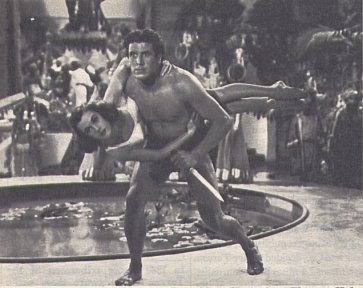
Glenn Morris, an Olympic Decathlon Champion and Eleanor Holm, a swimming star.
But their acting did not match up to their acro- and aquabatics,
so Tarzan's Revenge, made in 1938 was their only film.The fine-boned heir to rolling English acres is christened Tar-Zan, 'white skin' in the language of the apes. Pale and far from hirsute, he grows up in the jungle, causing alarm at first to his foster parents as he takes so long to master tree-top skills, but revealing in the end his breeding and stock and rising to become King of the Apes. "His straight and perfect figure, muscled as the best of the ancient Roman gladiators must have been muscled, and yet with the soft and sinuous curves of a Greek God, told at a glance the wondrous combination of enormous strength with suppleness and speed. . . With the noble poise of his handsome head upon those broad shoulders, and the fire of life and intelligence in those fine, clear eyes, he might readily have typified some demi-god of a wild and warlike bygone people of his ancient forest."
And then, at about the age when is aristocratic English contemporaries were leaving the playing fields of Eton for Sandhurst, Oxford or Cambridge, young Tarzan meets Jane, a Baltimore belle who is the daughter of the brilliant but bumbling Professor Porter (comic relief here). The Porters, father and daughter have both suffered that evidently common hazard of voyaging along the coast of West Africa -- being put ashore by a mutinous crew. And with them is one William Cecil Clayton who, by pure coincidence, is related to the Greystoke Claytons and stands, in fact, to inherit the Greystoke title unless Tarzan can prove his rightful claim.
The romantic climax comes when Terzok, son of Tublat, the genuine ape with whom Tarzan has been fostered as a brother makes off with Jane. The true Lord Greystoke swings to the rescue. "Jane Porter -- her lithe, young form flattened against the trunk of a great tree, her hands pressed tight against her rising and falling bosom, and her eyes wide with mingled horror, fascination, fear and admiration -- watched the primordial ape battle with the primeval man for possession of a woman -- for her . . . it was a primeval woman who sprang forward with outstretched arms to the man who had fought for her and won her.
"And Tarzan?"
"He did what no red-blooded man needs lessons in doing. He took his woman in his arms and smothered her upturned panting lips with kisses."
The 20th century had a new idol, with the strength to outlive Mickey Mouse, Superman or Sexton Blake because he appealed to the very oldest of instincts. Edgar Rice Burroughs had presented to an orderly, pinched society the gesture of defiance the folk memory called for. For small boys Tarzan was more convenient than a cowboy: he didn't need a horse. And the fact that he was fostered by animals and did without a human father or mother coped very neatly with the aggression we all feel, but dare not acknowledge, towards our parents. Tarzan's monkey upbringing subligated the same resentments that children's stories usually load on to cruel stepmothers and wicked uncles.
And he did the same for grownups. This snobbish English Lord, who seldom shaved and never went tot he lavatory, shamelessly voiced the prejudices men are racked by but seldom dare acknowledge. "Imagination is but another name for super-intelligence. Imagination it is which builds bridges and cities and empires. The beasts know it now, the blacks only a little, while to one in a hundred thousand of earth's dominant race it is given as a gift from heaven. . ." (New Stories of Tarzan, 1916-1917.)
Tarzan encounters approvingly the caste structure of Ancient Rome's empire in Africa: the black -- servants and slaves; the brown -- soldiers and shopkeepers; and the whites -- aristocrats and rulers. In Tarzan and the Leopard Men he appears "clothed in the dignity of power and authority. The change was so subtly wrought that it was scarcely apparent and was due, doubtless, to the psychological effect of the reawakened mentality of the white man over that of his black companions."
As male self-confidence flinched in the Twenties under the onslaught of female emancipation, Tarzan put the fair sex firmly in its place, encountering, for example, in Tarzan and the Ant Men a disgusting race of women, the Alalus, whose "hideous life . . . was the natural result of the unnatural reversal of sex dominance. It is the province of the male to initiate love and by his masterfulness to inspire first respect, then admiration in the breast of the female he seeks to attract." But refusing to accept this natural order of things and treating her man "with contempt and brutality", the Alalus woman became an unsexed "great brute. . . . Its long hair fell, unkept, about its shoulders, and there was hair on its chest. . . As it walked it flapped its large flat ears and occasionally move rapidly portions of its skin to dislodge flies, as you have seen a horse do with the muscles along its sides and flanks."
Edgar Rice Burroughs's attitude to sex could best be described as a genteel voyeurism: "Save for her highly wrought ornaments, she was entirely naked, nor could any apparel have enhanced the beauty of her perfect and symmetrical figure." Passion throbbed aplenty through his pages but never once did Tarzan so much as rumple Jane's hide gymslip. Their offspring presumably came from some jungle-fresh and immaculate conception.
He passed judgment on pacifists -- "war makes men of us" -- and liberals -- "these are the traitors, these are the men who are hastening the day when Moscow will dictate the policies of the world". There were those who suggested that the ape-man's anger in this respect was not unconnected with the Russians' refusal to pay his author any royalties for the millions of Tarzan stories they pirated. But whatever the reason, the loin-clothed superman provided exactly the comfort that male middle America needed in a perplexing, changing world.
Tarzan of the Apes was first published in All-Story Magazine for October 1912, and two years later A. C. McClurg and Co. published the tale as a fully fledged novel. "Not literature," said the St. Paul Pioneer. "Yet if you do not scorn the movies you will probably read through.
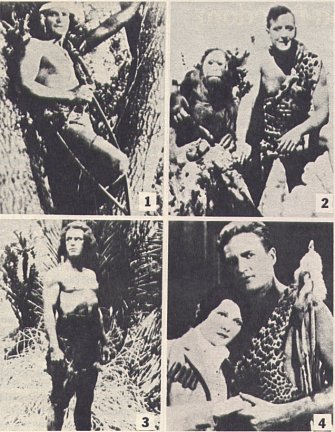
1. Elmo Lincoln, the first screen Tarzan was nearly bald and had to wear a wig.
2. Gene Pollard was paid only $100 a week to be his successor, so went back to being a fireman.
3. Kamuela Searle, the Son of Tarzan, was killed by an elephant during filming.
4. James H. Pierce (here with Edna Murphy), married in real life, Joan, the daughter of Edgar Rice Burroughs.
The couple recorded, with Joan as Jane, 364 episodes of Tarzan's Radio Adventures.Edgar Rice Burroughs certainly did not scorn the movies or anything else that would make him money. Tarzan of the Apes was turned down by the American Film Company as "not practical for picture purposes", and that corporation proceeded to the oblivion it deserved. But the National Film Corporation of America saw the epic's potential. Burroughs promised "not two or three lions, but a herd of twenty or thirty; that lions will be actually roped and killed by Tarzan; that two or three thousand cannibals will take part in the battle" and that "the largest and finest specimens of apes" would be used.
In the event these apes, including young Tarzan's foster mother, Kala, were played by husky members of the New Orleans Athletic Club draped in skins. And when the muscular ukulele player booked to play Tarzan marched off patriotically to join the army, his place was taken by a strong man, Otto Linkenhelt. But with his Germanic name changed to Elmo Lincoln, the strongman did keep one of Burroughs's promises, for he stabbed to death, in self defence, a not-so-drugged lion which woke up too early from its injection. The carcass wound up as a lobby display at the Broadway premiere.
With the release of this film, one of the first half dozen movies to gross over a million dollars, the Tarzan bandwagon was rolling rapidly and profitably. Only eight years after facing ruin as a penniless pencil-sharpener salesman Edgar Rice Burroughs was purchasing a former Press Lord's palace in the centre of a 540-acre estate near Los Angeles and embellishing the grounds with no less than five pools. He gave free movie shows every Friday night for audiences of 150 or 200 local citizens, and these lucky neighbours showed their appreciation by rechristening their community with the name it bears to this day -- Tarzana.
He could complete a book in a month, writing a steady five hours a day, five days a week. He liked to have a graph in front of him to chart his word output. Sometimes he would dictate directly to his secretary, more often -- and always in the case of love scenes, which it embarrassed him to dictate to her -- he would use a Dictograph. He got into the habit of keeping this by his bed, waking to mumble into it paragraphs of small hours inspiration which would usually go straight into the final manuscript, for he seldom altered his first draft. He began insisting that his publisher sprint his full name on every right-hand page of his novels, and when they expressed surprise at this unusual conceit he took steps to establish his own publishing house. From 1931 Burroughs Inc. published all the new Tarzan books along with the John Carter series of Martian adventures, a Venus series, a series set in Pellucidar ( a kingdom at the earth's core), a collection of assorted Western adventures, and a dozen miscellaneous other tales.
Nowhere abroad did the books of Edgar Rice Burroughs go down better than in Germany -- with over 20 million readers there he was the country's best selling foreign author ever -- but then came Tarzan the Untamed, a catastrophic setback. For Tarzan the Untamed told the story of the apeman's revenge on a dastardly Teuton, Hauptman Fritz Schneider, who, as some obscure part of Germany's First World War campaign in Africa, kidnapped Jane and stripped her of her rings. These he slipped on to the charred fingers of a dead and mutilated negress, leaving the body in the burning ruins of the estate near Nairobi to which Tarzan had, for reasons unexplained, moved since his upbringing on the West African coast.
Hauptman Schneider's ruse succeeded all too efficiently. For Tarzan, believing his wife to have been murdered, became possessed with hatred for "everything German, animate or inanimate". He enlisted as somewhat incongruous allies Britain's 2nd Rhodesian Regiment and Numa, a male lion that was starved into a frenzy of ferociousness and whom he set upon a patrol of Germans cornered in a deep cul-de-sac trench. Not wanting to miss out on the slaughter, Tarzan dived at one particular officer himself, biting through the Kraut's jugular. "The eyes of the Hun bulged with terror as he vainly struck with futile hands . . . Tarzan suddenly spun the man about . . . placing a knee in the middle of his back, and an arm about his neck . . . Something snapped and Tarzan cast him aside, a limp and lifeless thing."
The apeman caught up with an officer named Schneider and contrived to leave him clutching at the branch of a tree while Numa paced hungrily beneath. But then discovering that he had fed the lion the wrong Schneider, he gave himself the pleasure of inflicting a second revenge. "Tarzan brought the sharp point of his dagger to the lower part of the German's abdomen. 'Thus you slew my mate,' he hissed in a terrible voice. 'Thus shall you die!'"
At this point in the tale a beautiful Teutonic double agent rushes forward. "'Oh, God no! Not that! You are too brave -- you cannot be such a beast as that!'
"Tarzan turned to her. 'No,' he said, 'you are right, I cannot do it -- I am no German!' and he raised the point of his blade and sunk it deep into the putrid heart of Hauptman Fritz Schneider."
Anticipating that none of this was likely to go down too well in post World War I Germany, Burroughs's Stuttgart publishers, Charles Dieck and Co., decided to give Tarzan the Untamed a miss. But a journalist got hold of an English edition of the book and published in Berlin a graphic synopsis under the title Tarzan the German-Devourer. The reaction immediate, violent and sustained. When in May 1933 thousands of students bore torches along the Unter den Linden to fire some 30,000 books before the University of Berlin, Edgar Rice Burroughs was included in the pantheon that embraced Einstein, Thomas Mann, Freud and Zola. And in 1934 the Berlin Film Control Board banned any further screening of Tarzan of the Apes as "dangerous to Nazi principles of race-consciousness". Burroughs's naked adulation of Aryan superiority was set aside.
It was the first of many acts of homage paid by censors all over the world to the power of the apeman. Hungary has placed Tarzan on its list of proscribed bourgeois books. Cuba uses clips of Tarzan films to illustrate America's racial fantasies. In Russia collective farmers enjoyed old Tarzan movies looted from the ruins of Berlin until Pravda denounced these sessions for disturbing the chickens and pigs. And, in 1962, Tarzan was banned from libraries across the United States after a Los Angeles parent complained that the apeman and Jane were not married and, worse, that they had a son and even a grandson. Useless to protest that back in 1913, on page 313 of Return of Tarzan, the couple were wed by Jane's father, Professor Porter, an ordained minister. In Los Angeles, Baton Rouge and Long Beach, California, Edgar Rice Burroughs went into the cupboard with D. H. Lawrence. "Me Tarzan, Me Banned," complained the Pittsburgh-Post Gazette.
And Tarzan has suffered more subtle censorship. Created and presented in a convoluted aspidistra style long since overtaken by literary trends, he has been condemned to the same fate as The Three Musketeers or the Count of Monte Cristo. We know all about them, but we do not read Dumas. Adventure, escapism and unashamed fantasy are out of fashion -- or rather, in the never-waning flood of woman's story magazines and romantic novels -- they are so strongly in fashion that serious critics feel threatened and ignore them completely.
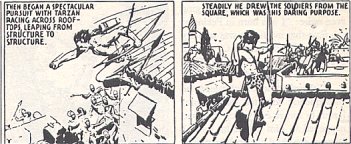
Tarzan first went into comic strip in 1929 by Hal Foster,
who went on to create another great strip hero, Prince Valiant.Still, Edgar Rice Burroughs never got upset about that sort of thing. He wrote, he always said, not with any literary ambition but as an escapist -- to escape being broke. And if that really was the limit of his ambition then he fulfilled it utterly, amassing through his writings the best part of $5 million, until he died one Sunday morning in 1950 at the age of 74, reading a comic in bed. He had grown eccentric, nagging at his secretary to economise by using up a stock of rusty paperclips he had brought back from Hawaii, where he had spent most of the Second World War. He had worked there as a war correspondent -- the oldest on any side, too ill for combat assignments (ed: not entirely correct - see ERB: The War Years), so given propaganda work, denouncing Hirohito as a "syphilitic near-imbecile" and praising the BMTC, a sort of American Home Guard, as "swell citizens and real patriots, living proof that America is not a decadent nation of conscientious objectors".
Though he made enough money to spend his life permanently on safari in the continent from which his hero came, he never once set foot in Africa -- as is evident from his books. In the very first Tarzan story he included tigers which he had to change later into lionesses, panthers and leopards to remain true to the African facts of life, while the carnivorous six-foot apes who fostered the little Lord Greystoke were a totally fictitious mixture of chimpanzee, gorilla and oran-utan (all vegetarians). His jungle was Douanier Rousseau's, not the real thing. The legendary Tarzan yell was not some authentic wild beast's cry, but the product of an afternoon in a Hollywood sound-mixing studio mucking around with violin strings, soprano top Cs, a growling dog and a human yodel.
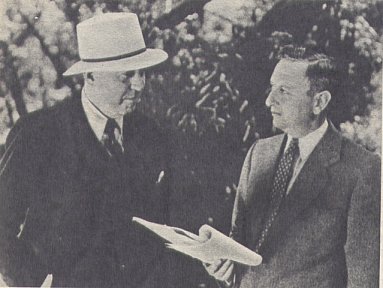
Edgar Rice Burroughs (left) with Sol Lesser, the great Tarzan movie mogul who,
between 1933 and 1958, produced 16 profitable apeman adventures.
Devotees were able to spot in his films footage repeated from previous epics.
One crocodile battle was used in five adventures.
In 1958 Lesser dropped $2 million for his company, plus Tarzan's loincloth.Yet that is the very appeal of Tarzan's world, Prester John's fantastic and fabled dark continent of romance and treasure, the world of Wappi the Antelope and Tantor the Elephant and the friendly Waziri tribe, where gorillas can, for the most plausible of reasons explained in Tarzan and the Lion Man, organise themselves into cities and give each other names like Henry VIII, Cardinal Wolsey and the Duke of Buckingham. To have seen 20th-century Africa as she really is would have been too cruel a disillusionment for a man who knew fantasy's value and fragility. In the very last chapter of Tarzan and the Lion Man Edgar Rice Burroughs brings the apeman to Hollywood for the one and only time in his literary career. He gets a job as an extra in a jungle epic, when a lion breaks out of its cage and menaces the cast. The actor playing the hero turns tail and runs, but Tarzan leaps on to the back of the ferocious beast and subdues it. "An excited man rushed on to the set. It was Benny Goldeen, the production manager.
"'My God . . . You've killed our best lion! He was worth ten thousand dollars if he was worth a cent. You're fired!'"
"'Tarzan goes back to his hotel to check out. "The clerk at The Roosevelt looked up. 'Leaving us, Mr. Clayton?. . . I hope you have enjoyed Hollywood?'"
Our hero, a gentleman as ever through the worst of adversity, smiles graciously. "'Very much indeed. But . . . what is the shortest route back to Africa?'"
Web Refs:
Edgar Rice Burroughs Bio Timeline
ERB: The War Years
e-Text Editions of the ERB Novels
ERB and the Press
A Life's Journey Through the Newspapers of the World: 1875-1950


WEBJED:
BILL HILLMAN
Visit
our thousands of other sites at:
BILL
AND SUE-ON HILLMAN ECLECTIC STUDIO
All
ERB Images© and Tarzan® are Copyright ERB, Inc.- All Rights Reserved.
All
Original Work ©1996-2006/2018 by Bill Hillman and/or Contributing
Authors/Owners